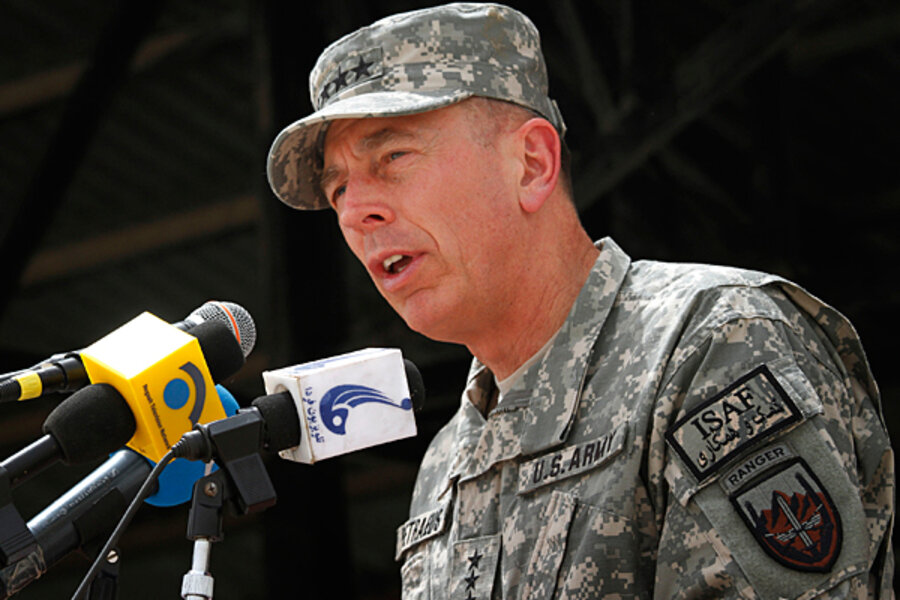Afghanistan war: Will the new Petraeus rules of engagement make troops safer?
Loading...
| Boston
Gen. David Petraeus, appointed this June to turn the Afghanistan war around, has just made his first visible impact on how the increasingly deadly conflict is being run.
On Wednesday General Petraeus revised the Afghanistan rules of engagement, which are guidelines for when and how the US and other NATO troops under his command can shoot to kill. At the time of his confirmation that a rethink of the strict rules put in place by his predecessor Gen. Stanley McChrystal – which many combat troops complained put protecting Afghan civilians ahead of protecting them – was likely.
Now, he's issued a change in approach that appears to relax the rules around the edges, while maintaining the priority at the heart of NATO's counterinsurgency, or COIN, strategy in Afghanistan: "Concentrating our efforts on protecting the population," as his new directive, released Wednesday, says. The full directive is classified, according to the International Assistance Force in Afghanistan (ISAF), the mission Petraeus leads. But the excerpts from Petraeus's rules released on the ISAF website place more emphasis on the appropriateness of lethal force than the McChrystal order it replaces.
The nuanced shift in the rules is no surprise. Some officers privately said that under McChrystal the priority on protecting Afghan civilian lives had become too doctrinaire and that, in practice, officers were reluctant to return fire or use artillery against attacking insurgents because of the presence – or possible presence – of Afghan civilians among them.
A Washington Post article by the conservative columnist George Will on June 20 – days before Petraeus replaced McChrystal – pointed out an e-mail from a noncommanding officer in Afghanistan who complained that an officer denied him permission to fire an illumination round to reveal the position of Taliban fighters who were mortaring his position at night "on the grounds that it may cause collateral damage." Illumination rounds typically float to the ground on small parachutes and are the closest thing to nerf artillery in the US arsenal. They could only kill or injure if they landed on top of someone and set that person on fire.
Such approaches appear to be what Petraeus is trying to address – both to improve "force protection" – and, perhaps, to improve morale and belief in the mission among the rank and file.
While emphasizing the logic at the heart of the COIN doctrine ("if we use excessive force or operate to the contrary to our counterinsurgency principles, tactical victories may prove to be strategic setbacks") and calling for no use of artillery or air power "when civilians are present" it does say there are two exceptions.
What are they? That precise language is redacted "due to operational security; however, they have to with the risk to ISAF and Afghan forces," the website says.
Petraeus also says that troops should not be placed at any more risk than necessary:
"We must remember that it is a moral imperative both to protect Afghan civilians and to bring all assets to bear to protect our men and women in uniform and the Afghan security forces with whom we are fighting shoulder-to-shoulder when they are in a touch spot," Petraeus writes [Emphasis in original]. "This directive, as with the other previous version, does not prevent commanders from protecting the lives of their men and women as a matter of self-defense where it is determined no other options are available to effectively counter the threat."
What this will mean in practice is hard to say. With 101 NATO casualties in June, that month was the deadliest of the 9-year-old war for foreign troops. July's death toll of 66 US service members made that month the deadliest of the war for the US. And most NATO casualties are the result of improvised explosive devices (IEDs) placed on roads and footpaths, against which air power or guns are of little use.
Civilian casualties have been a major source of tension between NATO forces and the Afghan government of President Hamid Karzai, who has railed in the past against the loss of civilian lives at NATO hands – though human rights workers in Afghanistan say the vast majority of civilians now dying in Afghanistan are being killed by the Taliban.
An incident Thursday also demonstrates how difficult it will be to succeed if a crucial measure of success is cutting civilian casualties close to zero, and of the chaos and imprecision of monitoring during a war. ISAF said in a statement that "between four and a dozen or more civilians" were killed by "air weapons" in the eastern province of Nangarhar after a joint NATO-Afghan team that raided a Taliban compound came under attack as they withdrew.





